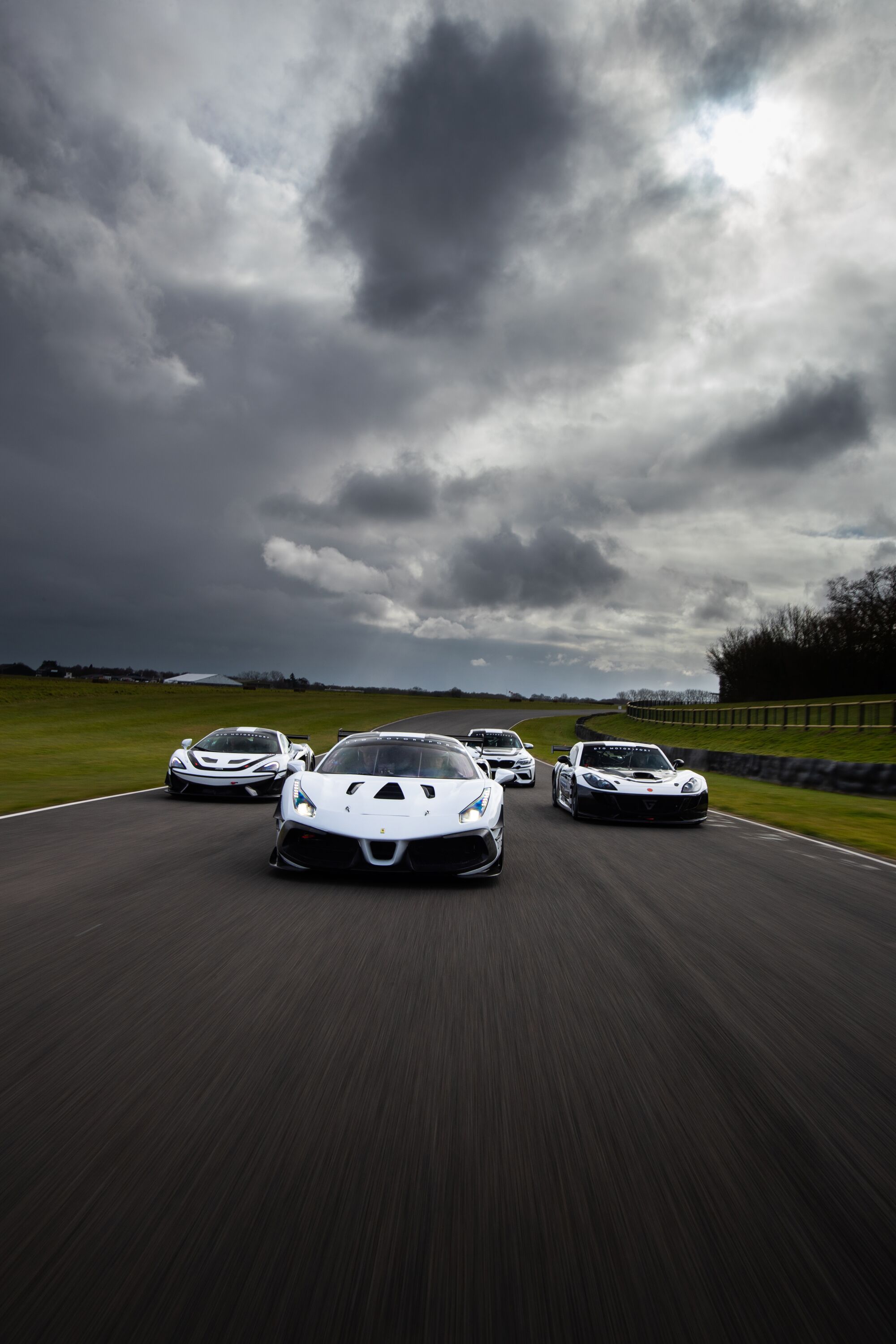The best Holden road cars
While we are spoiled with an abundance of fast saloons from the UK and Germany on our fair shores, muscle car-based four-doors are hard to come by. And Australia's answer to fast family transport is almost non-existent in the UK — at least since Vauxhall stopped importing Holdens under its Monaro and VXR nameplates. Here, though, you can see Holden Special Vehicles (HSVs) as far as the eye can see, spanning the fastest to the most interesting. These are the ten Holdens we wish we got in the UK.

2004 HSV VZ Coupe 4
HSVs have a reputation for being tail-happy pussycats that could be taken to the edge of adhesion without fear of bite back, but not all its cars were built with big kids in mind. Aimed at a more grown-up buyer, the VZ Coupe 4 — HSV’s only four-wheel-drive model — swapped the antics of a rear-wheel drive chassis for the assurance of all-wheel traction.
HSV even toned down the looks; no OTT body kits here, the Coupe 4 got stretched wheel arches to accommodate its four-wheel drive and that was about it, even the paint was conservative. Unfortunately, HSV's grown-up Holden wasn't executed as well as it could have been. Fitting the four-wheel drive system seriously reduced boot space and added almost 150kg to its weight, and the new packaging required a reworked intake that compromised power.
Factor in the ponderous four-speed automatic gearbox (the only available option) and the Coupe 4 was the slowest car HSV made at the time. In fairness, turning all four wheels gave it bad-weather performance no other HSV could match, and its twin exhaust meant it sounded throatier than the rest of the range, too.

1996 HSV GTS-R
Australian fast four-doors wear their hearts on their sleeves, but even by Holden standards 1996's VS GTS-R, with its Bathurst-ready rear wing and tuner-special three-spoke alloys and XU3 Yellah paint, stands out like a peacock in a hen coop. But it's not all show and no go. When legendary Australian tuner Ron Harropp stroked Holden’s five-litre V8 to 5.7 litres, HSV wanted a piece of the action and requested that two engines be shipped to the factory for evaluation.
Having established that the engine "went like hell", it was decided the V8 would be the heart of the new GTS-R. Producing 292PS (215kW), it was quite a feat in the 1990s, but it was the torque of a deathrolling croc that really impressed. With 475Nm (350lb ft) available from just 3,600rpm, the HSV was a road-train-overtaking monster.
Thankfully, HSV didn’t just fit the motor and cross its fingers. The suspension was uprated as were the brakes, you got a Hydra-Trak LSD and so much carbon fibre (for the air intake, side skirts, rear trim panel, rear bumper highlight, and wheel centre caps) Holden set up a standalone company to produce it.

1968 Holden HK Monaro GTS 327
The Monaro only became known to us in the early ‘00s, but down under, it had existed since the early ‘60s thanks to the HK Monaro. The HK Monaro was designed to unpack the same magic as the Ford Mustang had done stateside by offering a cool two-door coupé to appeal to younger buyers, with V8 power and proven pedigree in motorsport.
Winning the Bathurst 500 was all the advertising a new car needed, which is why Holden built the HK Monaro GTS 327. It wrote the rulebook on Australian muscle cars, marrying a 253PS (186kW) 5.7-litre Chevrolet V8 engine to a manual gearbox and a limited-slip differential that meant the car could make the most of its power, while a huge fuel tank gave it the legs needed for racing.
Outside, you got an offset bonnet stripe, sill stripes and inside, you got a rev counter. The car laid the foundations for every Australian muscle car that came after it.

2017 Holden Maloo GTSR W1
The UK was only getting used to the idea of an Australian muscle car – the Vauxhall-badged Monaro – when Holden boomeranged back with a subtle twist on the concept, a ute called the Maloo. The idea wasn't as alien to us as it might have appeared at first glance; readers of a particular vintage will remember the Ford P100, which stuck a truck body on the chassis of a Ford Sierra to build a truck with car-like handling.
The HSV Maloo did a similar thing. It only offered sports-car-like performance, while the GTSR W1 you see here could keep a supercar honest. Four W1s were built, each featuring a 6.2-litre LS9 supercharged V8 good for 644PS (474kW) and 0-62mph in 4.1 seconds.
It has a shouty body kit, 20-inch wheels, Pirelli P-Zero Trofeo R tyres, AP brakes, and a tightly packed six-speed Tremec gearbox. The result was arguably the epitome of performance utes and sold for well over one million Australian dollars at auction.

1977 Holden Torana A9X Hatch
US engineer George Roberts was the boss of Holden back in 1975. He was famous for engineering the Boulevard Ride of Cadillac, bringing much of what he learned Stateside over to Australia. Unfortunately, Roberts also thought terminal understeer was a safety feature and engineered it into every Holden he put his name to.
When GM's director of international operations, Alex Cunningham, drove an assortment of Holdens, the problem was spotted. Hardly believing how bad the cars drove, Cunningham reported his concerns back to Detroit and Roberts was gone within months. It was left to a group of Opel engineers to sort out Holden cars, releasing the Radial Tuned Suspension package that returned the neat handling expected of a Holden.
It was from these foundations that the A9X was built. It got the floorplan from the forthcoming UC Torana and steering gear mounted directly to the chassis for much more feel. Power came from a 5.0-litre V8, and the car had a fibreglass bonnet and wheel arch extensions. The car would come to be known as Australia's Porsche 928.

1985 Holden Dealer Team VK SS Group A Commodore
The VK SS Group A Commodore, nicknamed the 'Blue Meanie', was a limited-run homologation special built to compete in Group A touring car racing. Just 500 were built in total. Hidden under the body kit and 16-inch HDT wheels was the body of what UK readers would recognise as an MK2 Vauxhall Cavalier. However, underneath, it was very different.
The Commodore followed the familiar muscle car recipe with power from a 4.9-litre V8 with roller rockers and high-lift cams that produced 266PS (196kW) through a four-speed manual gearbox and a limited-slip differential.
The car had many notable successes, including first and second place at 1986's Nissan Mobil 500 at the Wellington Street Circuit and victory at the Pukekohe 500 in New Zealand. The car was less successful in Europe, although it held the touring car lap record at Hockenheim until 2000.

1974 Holden LH Torana SL/R 5000 L34
With its stretched wheel arches and ducktail spoiler, Holden's first V8 Torana, the SL/R 5000 L34, is the kind of car we picture in the context of Australian touring car racing. That the vehicle won Bathurst twice back-to-back only solidifies this thinking.
A road car built for racing, the Torana embodies everything you expect of an Australian muscle car, with a big V8 engine pushing along a mid-sized saloon body. It’s 308 V8 featured a strengthened block, rods, pistons, and crankshaft uprated for racing, a special cam, roller rockers and a performance head.
Unsurprisingly, while Holden (to keep the anti-fast-car lobby happy) claimed the 5000 produced 268PS (197kW), the actual figure was thought to be 50 per cent bigger. Just 263 L34s were built, and fewer than 40 are thought to exist today.

2017 Vauxhall VXR8 GTS-R
The eagle-eyed amongst you will have noticed one glaring problem with the Vauxhall VXR8 GTS-R – it's not a Holden. The method behind this madness is that we wanted to offer you a Holden you can go out and buy, and because Holdens weren't sold in the UK, this Vauxhall is the next best thing.
We say 'Vauxhall'. The reality is that the VXR8 GTS-R is a rebadged Holden – a very good one. Built to mark the end of VXR8 production, just 15 GTS-Rs were built, powered by a supercharged V8 that produced 586PS (438kW).
The VXR8 was the antithesis of a German performance saloon; out went the sophisticated chassis setups and flash interiors of a BMW or Mercedes, and in came a plastic-feeling cabin, bucket loads of charisma and a price tag that would make the European competition weep onto their Bratwurst.

1969 Holden HT Monaro GTS 35
The GTS 350's legendary status was confirmed when it took victory at Bathurst in 1969 against the favourite, a Ford XW Falcon GT-HO, in the hands of Colin Bond and Tony Roberts. However, it was also the car that debuted Peter Brock's Bathurst. He'd have a 40-year relationship with Holden, winning the Bathurst 500 nine times and owning the Holden Dealer Team from 1980.
The Holden featured kit like an LSD, anti-axle-tramp rear suspension, lightweight wheels, a high-flow air filter and a long-range fuel tank. The GTS added Chevrolet's legendary small block 5.7-litre V8 – for 305PS (224kW), 0-62mph in 7.5 seconds and a top speed of 129 mph – a wider track and uprated brakes.
A squared-off front end and a boxier rear with stacked tail lights provided the visual muscle, but you also got bonnet vents and decals. Inside was a rev counter in the instrument binnacle and the option to fit houndstooth upholstery.

1974 Holden Sandman
You might think the Ford Ranger Raptor created the niche for a commercial pickup truck that isn't designed for commercial duties, but Holden's Sandman beat it to the punch. The Sandman was never intended to haul the axle-breaking loads of a regal ute.
Instead, it was designed to make you look cool and perform well while having all the space needed for a surfing trip to the beach or scuba diving from the quayside.
Smart looks came in the form of eye-catching paint colours, decals, and steel sports wheels, while 'Sandman' was hand drawn on the B pillar. Power came from a range of options up to and including a special order 305ci Holden V8, which was more popular than the standard six-cylinder option.
road
news
Holden
List
-

Afternoon Tea and Tour
-

Guided Tours
-

Christmas Afternoon Tea, Tour and Carols
-

Guided Tours
-

Credit Membership





